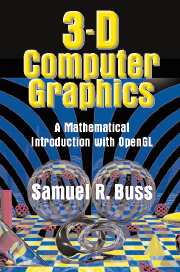Book contents
- Frontmatter
- Contents
- Preface
- I Introduction
- II Transformations and Viewing
- III Lighting, Illumination, and Shading
- IV Averaging and Interpolation
- V Texture Mapping
- VI Color
- VII Bézier Curves
- VIII B-Splines
- IX Ray Tracing
- X Intersection Testing
- XI Radiosity
- XII Animation and Kinematics
- A Mathematics Background
- B RayTrace Software Package
- Bibliography
- Index
- Plate section
Preface
Published online by Cambridge University Press: 05 June 2012
- Frontmatter
- Contents
- Preface
- I Introduction
- II Transformations and Viewing
- III Lighting, Illumination, and Shading
- IV Averaging and Interpolation
- V Texture Mapping
- VI Color
- VII Bézier Curves
- VIII B-Splines
- IX Ray Tracing
- X Intersection Testing
- XI Radiosity
- XII Animation and Kinematics
- A Mathematics Background
- B RayTrace Software Package
- Bibliography
- Index
- Plate section
Summary
Computer graphics has grown phenomenally in recent decades, progressing from simple 2-D graphics to complex, high-quality, three-dimensional environments. In entertainment, computer graphics is used extensively in movies and computer games. Animated movies are increasingly being made entirely with computers. Even nonanimated movies depend heavily on computer graphics to develop special effects: witness, for instance, the success of the Star Wars movies beginning in the mid-1970s. The capabilities of computer graphics in personal computers and home game consoles have now improved to the extent that low-cost systems are able to display millions of polygons per second.
There are also significant uses of computer graphics in nonentertainment applications. For example, virtual reality systems are often used in training. Computer graphics is an indispensable tool for scientific visualization and for computer-aided design (CAD). We need good methods for displaying large data sets comprehensibly and for showing the results of large-scale scientific simulations.
The art and science of computer graphics have been evolving since the advent of computers and started in earnest in the early 1960s. Since then, computer graphics has developed into a rich, deep, and coherent field. The aim of this book is to present the mathematical foundations of computer graphics along with a practical introduction to programming using OpenGL. I believe that understanding the mathematical basis is important for any advanced use of computer graphics. For this reason, this book attempts to cover the underlying mathematics thoroughly.
Information
- Type
- Chapter
- Information
- 3D Computer GraphicsA Mathematical Introduction with OpenGL, pp. xi - xviPublisher: Cambridge University PressPrint publication year: 2003
